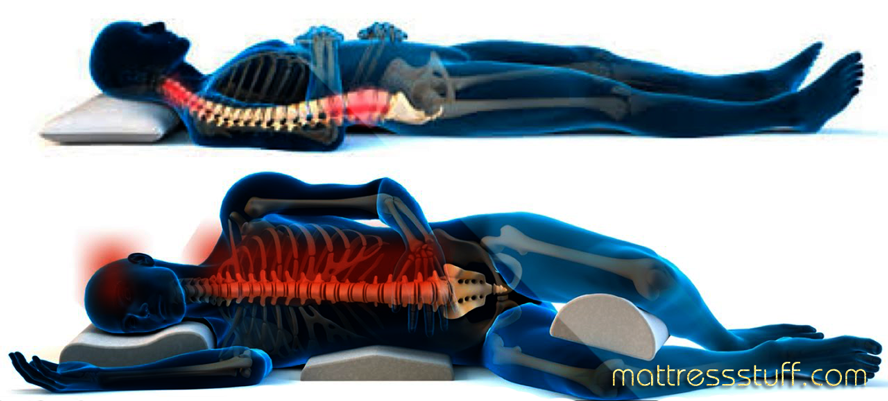
Table of Contents
Many doctors and health experts have proved that sleep positions can play an important part in preventing some spine diseases and back problems.
Sleeping in the wrong position can place immense strain and pressure on your back or neck, which often leads to a painful feeling when waking up. In the next sections, we will show you useful tips in 5 sleep situations to prevent spinal pain and stay comfortable.
Note that alignment is the key
No matter what sleep situations to prevent spinal pain that you choose, keeping a proper alignment of the spine is always the most important thing.
Specifically focus on aligning your hips, shoulders, and ears, as well as notice the gap between the bed and your body which strain your spine and muscles. To maximize support, you can use a small pillow to fill these gaps and reduce the tension.
1. Reclined sleeping position
Do you feel really comfortable when snoozing in the recliner? Though sleeping in a chair might not be the best way to avoid back pain, this posture can be helpful if you are suffering from isthmic spondylolisthesis.
Reclining would be beneficial since it helps create an angle between your trunk and thighs to reduce the tension on your spine. What’s more, consider purchasing an adjustable bed so that you can sleep in this position with the best support and alignment.
2. Fetal sleeping position
Another healthy sleeping position to prevent spinal problem like herniated disk is the fetal posture. Basically, you will sleep on your side but curled as a fetal in the women belly.
Firstly, you need to lay on the back and gently roll over on your side. After that, tuck your knees towards your chest and curl the torso gently to your knees. Keep in mind to switch sides constantly to avoid any imbalances.
3. Side sleeping position
The most common position posture is side sleeping, particularly among women. While it might put some strain or tension on your body, ensuring your shoulders and hips are supported properly can make it comfortable.
Ideally, a side sleeper should slightly bend in both knees and put a small pillow between the legs to keep your hips from being twisted and exerting stress on your back. If the legs are stretched too tightly, the back might round, while it might worsen your lower back’s curve when the legs are too straight – and both can result in back pain.
4. Back sleeping position
The back sleeping position is often what you will see recommended as an ideal posture for back problems. And this is actually true. As the second most common position, sleeping on your back with a good mattress can provide great support to your spine and neutral neck.
For back sleepers, the back should keep a neutral curve like standing. Your neck should ideally rest at a neutral angle to the shoulders, while your heels, hips, and shoulders should be straight. If you see a large gap between your bed and back or feel pressure on the hips or upper back, chances are your mattress seem to be too firm.
5. Stomach sleeping position
In general, sleeping on the stomach or belly is often regarded as the least ideal posture for spine diseases or back problems mainly because the lumbar region can be left unsupported. This eventually places a huge pressure on your lower back muscles, spine, shoulders, and neck. In worse cases, this sleeping posture can also cause your spinal joints to compress.
For stomach sleepers, it is important to keep a neutral curve that is similar to your upright posture. And the easiest way to achieve this is to use a pillow below your hips. To support the body better, put a pillow beneath your lumbar region and pelvis. At your head, it is better not to use a pillow or just use a flat pillow so as not to cause tension on your lower back.
Final thoughts
In overall, sleep position is just as important as your daytime posture, especially when you are trying to prevent spine problems. In general, you should sleep on your back and supported side because they are ergonomic and keep your spine aligned with the head and neck.
Avoid a stomach posture as it increases the risks of back pain when you wake up in the morning. After reading, we hope that you can have a better understanding of the best sleep situations to prevent spinal pain and have a better life.







